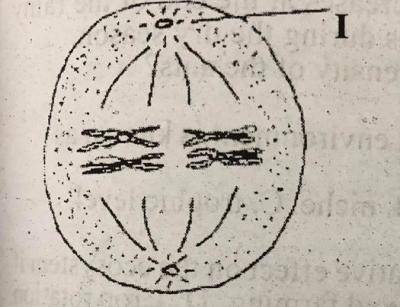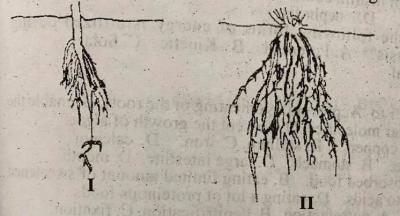The heart can beat continuously without being fatigued because it is composed of________
- A. skeletal muscles
- B. smooth muscles
- C. cardiac muscles
- D. renal muscles
Muscle fatigue in the body of an athlete is due to__________
- A. low pH
- B. high oxygen content
- C. accumulation of lactic acid
- D. accumulation of carbonic acid
Underground storage stems which grow horizontally in the soil are_______
- A. bulbs
- B. runners
- C. rhizomes
- D. corms

Anaerobic respiration in the organism illustrated in the diagram above produces carbon dioxide and________
- A. ethanol
- B. water
- C. oxygen
- D. glucose
The rate of diffusion of molecules between two media will be higher if_________?
- A. the difference in concentration of the two media is low
- B. the difference in concentration of the two media is negligible
- C. the difference in concentration of the two media is high
- D. there is no difference in the concentration of the two media

The part labelled I is the________
- A. centromere
- B. spindle fibre
- C. centriole
- D. chiasmata

The diagram above is an illustration of a stage in a biological process. Study it and answer this question
What stage of cell division is illustrated in the diagram?
- A. Prophase
- B. Metaphase
- C. Anaphase
- D. Telophase

The classes of plants the root systems in diagrams I and II above represent respectively are______________
- A. Dicotyledoneae and Monocotyledoneae
- B. Monocotyledoneae and Dicotyledoneae
- C. Dicotyledoneae and Dicotyledoncae
- D. Monocotyledoneae and Monocotyledoneae
A structural similarity between Parameciumn and Amoeba is the presence of______
- A. one food vacuole
- B. two contractile vacuoles
- C. two nuclei
- D. one gullet
An example of organ level of organization is _______
- A. bird
- B. kidney
- C. spermatozoon
- D. xylem
Which of the following structures will NOT be found in the nucleus of a cell?
- A. DNA
- B. Nucleolus
- C. Lysosome
- D. Centriole
a. Complete the table below.
|
Organism |
Mode of feeding |
Feature of mouthpart that adapts organism to mode of feeding |
[6 marks]
b. List five parts of the alimentary canal of an earthworm. [5 marks]
c. State six ways by which water could be polluted by agricultural practices. [6 marks]
d. Describe briefly the life cycle of a housefly. [5 marks]
e. Make a diagram, 6 cm – 8 cm long of the hypogeal germination in a mature maize seedling and label fully. [8 marks]
a. Explain briefly the importance of the following factors and organisms in the nitrogen cycle
(i) lightning; [3 marks]
(ii) Nitrosomonas; [2 marks]
(iii) Azotobacter. [2 marks]
b. Name the excretory organ in:
(i) insects: [1 mark]
(ii) earthworm.
c. Define
(i) hepatitis; [4 marks]
(ii) kidney stones [4marks]
d. (i) State three effects of lack of sense receptors in the skin to humans. [3 marks]
(ii) List three layers of the epidermis in the skin of humans. [3 marks]
e. (i) What is metamorphosis? [2 marks]
(ii) State the type of metamorphosis exhibited by each of the following insects listed in the table below.
| Insect | Type of metamorphosis |
| Grasshopper | |
| Cockroach | |
| Butterfly | |
| Mosquito | |
| Housefly |
Use the information below to answer questions (a)(i) and (a)(ii).
Hb Are presents normal haemoglobin,
HbS represents sickled haemoglobin.
a. A female heterozygote for sickle cell married a sickler. With the aid of a genetic diagram, determine the:
(i) possible genotypes of their offspring; [8 marks]
(ii) phenotypic ratio of the offspring. [2 marks]
b. Explain briefly the reason why a Rhesus negative woman married to a Rhesus positive man might lose her second pregnancy. [5 marks]
c. Name two examples of features in animals that support the theory of use and disuse of body parts as used by Lamarck. [2 marks]
d. List three structures in mammals that are vestigial. [3 marks]
a. Classify the following biological associations under the headings in the table below:
(i) Remora and shark;
(ii) Lichen;
(iii) Cattle and white Egret;
(iv) Tapeworm in the gut of humans;
(v) Flowers and Honeybees;
(vi) Mistletoe and Cacao plant.
| Parasitism | Mutualism | Commensalism |
[6 marks]
b. (i) State three adaptive features of parasites. [6 marks]
(ii) State two effects of parasites on their hosts. [2 marks]
c. (i) What are saprophytes? [2 marks]
(ii) Give four examples of saprophytes. [4 marks]
The table below shows the percentage composition of fat and protein in six different meat types. Study it and answer questions 2(a) to 2(d).
| Meat Type | Fat (%) | Protein (%) |
| A | 07.2 | 21.3 |
| B | 25.3 | 10.6 |
| C | 20.0 | 22.5 |
| D | 03.1 | 28.2 |
| E | 12.6 | 17.3 |
| F | 13.2 | 14.3 |
a. (i) Which two of the meat types may be recommended for an obese patient? [2 marks]
(ii) State one reason for the answer in 2(a)(i). [1 mark]
b. (i) Which two of the meat types would provide the most energy? [2 marks]
(ii) State two reasons for the answer in 2(b)(i). [2 marks]
c. (i) Which three of the meat types could be recommended for a child suffering from kwashiorkor? [3 marks]
(ii) State one reason for the answer in 2(c)(i) [1 mark]
d. Which of the meat types would most likely be suitable for:
(i) an active teenager; [1 mark]
(ii) a 70-year old human? [1 mark]
e. Which other class of food provides energy? [1 mark]
f. State three uses of fat in the human body. [3 marks]
g. Describe briefly the procedure for testing for fat in a meat sample using a piece of white paper. [3 marks]
b. List five parts of the alimentary canal of an earthworm. [5 marks]
c. State six ways by which water could be polluted by agricultural. [6 marks]
d. Describe briefly the life cycle of a housefly. [5 marks]
e. Make a diagram, 6 cm – 8 cm long of the hypogeal germination in a mature maize seedling and label fully. [8 marks]
a. (i) Complete the table below with the respiratory surface of each of the listed organisms.
| organism | respiratory surface |
| Tadpole (2days old) | |
| Cockroach | |
| Domestic fowl | |
| Talinum | |
| Earth Worm | |
| Amoeba |
(ii) State five characteristic features of respiratory surfaces in organisms. [5 marks]
b. Make a drawing, 4 cm – 6 cm long of the respiratory organ in Tilapia and label fully. [9 marks]
A homozygous tall, red flower plant was crossed with a homozygous dwarf, white flower plant. The F1 were selfed and 160 F2 plants were obtained.
a.(i) Name the type of genetic cross. [1 marks]
(ii) State one reason for the answer in 4(a)(i). [1 marks]
b.(i) What is evolution? [2 marks]
(ii) With the aid of a genetic diagram, state the phenotypic ratio of F2 generation. [13 marks]
(iii) Calculate the number of tall and white flowers that would be obtained in the F2 generation. [3 marks]
a. State five :
(i) challenges that make conservation of resources difficult; [5 marks]
(ii) ways by which the Government of a country ensures conservation of natural resources. [5 marks]
b. What is an endangered species? [3 marks]
c. A child with blood group O was born to a mother of blood group A.
(i) What is the blood group genotype of the child? [1 marks]
(ii) What are the possible blood group genotypes of the father? [3 marks]
d. State three reasons why genetic variation is important to plants. [3 marks]
a. State three features of the small intestine that increase the rate of absorption of digested food. [3 marks]
b. Explain briefly what happens to the glucose formed in a plant during photosynthesis. [3 marks]
c. Explain briefly the mode of feeding in each of the following organisms:
(i) Euglena; [4 marks]
(ii) Spirogyra. [4 marks]
d. State three characteristics of an Estuarine habitat. [3 marks]
e. State three differences between an aquatic habitat and a terrestrial habitat. [3 marks]


